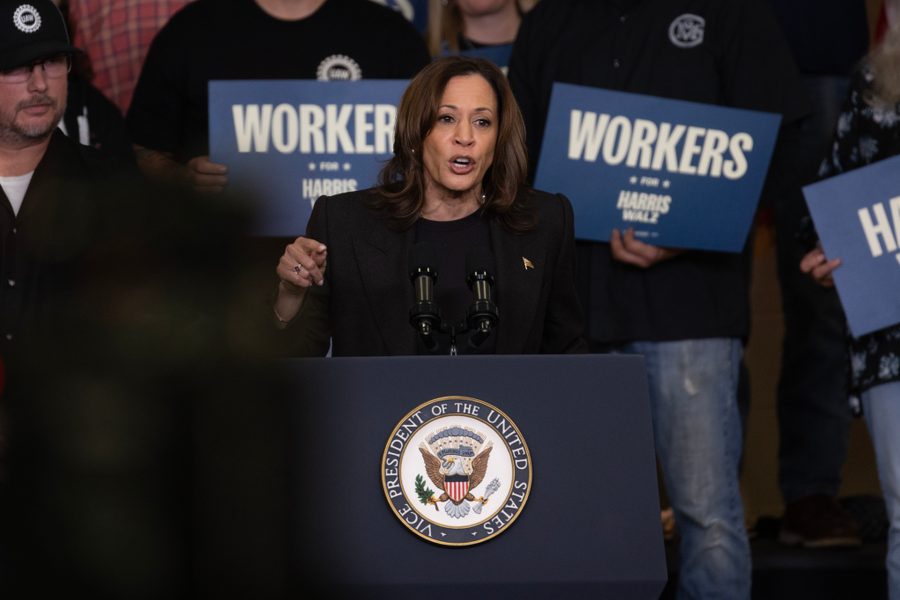Harris Is No Socialist—But Her Economic Plans Are Far Better Than Trump’s
Trump wants to throw more money at the super rich, while Harris is proposing spending on public programs to benefit the working class. While her plans don’t go nearly far enough, they’re superior to the alternative.
Max B. Sawicky

Modern U.S. presidential campaigns seem to have less and less to do with substance, a development spearheaded most recently by former President Donald Trump. As climate writer David Roberts has pointed out, trying to analyze Trump’s statements as policy commitments is a “category error.” Trump presses upon his followers the delusion that he can command the federal bureaucracy, corporations and foreign countries to do whatever he wants, even before taking office as president. His policies are simply Himself. These days he is tossing out proposals for tax cuts to miscellaneous constituencies, like somebody throwing beads from a parade float at Mardi Gras.
That voters care about any fine-grained details of a candidate’s policy platform may be doubted. Nevertheless, we should care, since the details point to potential changes under a future administration. Others talk about the politics of such proposals in pure horserace terms. When it comes to the emerging agenda from Vice President Kamala Harris’ campaign, I’m interested in the potential for socialist politics under her platform. Where might it lead?
Harris recently announced new proposals suggesting what her domestic policy agenda would look like, adding to a burgeoning economic plan I have previously reviewed.
Harris does have a lingering political problem from the inflation spike of 2022, since some voters have come to think a president either causes or can eliminate inflation. Another bit of common economic ignorance that Trump exploits is voters’ misimpression that foreign countries, rather than U.S. citizens, pay for tariffs. Without a doubt, new tariffs would raise the level of prices, as would the deportation of many workers, which Trump has promised.
It’s easy for a president to deliberately increase inflation with tariffs. (And by other means: I like to remind people when Trump wanted higher gas prices.) Reducing inflation, when it has arisen from other sources, is something else entirely. There are things a Democratic president, with the help of a cooperative Congress, could do to tame inflation, which has fallen dramatically in recent months. The three big areas are healthcare, higher education and housing.
On healthcare, what makes the U.S. system more expensive than it needs to be are the prices providers of medical care are able to charge. The Biden administration made progress in lowering some drug prices. With its control of the biggest purchasers of healthcare in the nation — Medicare and Medicaid — more could be done. Harris is onto this accomplishment, and, along with capping certain drug prices and out-of-pocket expenses, has proposed having Medicare cover the cost of home healthcare aides for seniors, and extending the program to vision and hearing. A related virtue is that the further progress she promises could actually save the government money in the long run. At the same time, the expansion of access to Obamacare she favors will cost money. A more comprehensive approach would mean pursuing a universal, guaranteed healthcare system.
On higher education, the federal government needs to reverse the long trend of austerity in aid to the states in order to reduce the cost of tuition at public community colleges and universities. There is also the related struggle to reduce the burden of student debt, since the Biden administration’s cancellation plan has been blocked by the right-wing U.S. Supreme Court. Harris could make a more forthright commitment to resume Biden’s efforts in this fight once in office.
On housing, the nation needs to recoup the fall-off in construction suffered during the pandemic and build a whole lot more units, especially those that are affordable. There are different ways to do this, with different roles for federal, state, and local governments, some of which entail spending money. The proposals in Harris’ plan are so far limited to tax credits. Public and social housing remain under-estimated approaches to this issue, one that is often at the heart of Americans’ economic anxiety.
Like most economists, I am skeptical about a president’s ability to reduce the prices of other consumer goods. The fact that inflation can be attributed to higher profits for corporations or, as Harris puts it, to “bad actors,” does not alleviate the administrative difficulties of controlling individual prices. For her part, Harris has promised to go after “price gouging” companies, though has offered few specifics as to how.
Harris has referred to her goal as establishing an “opportunity economy.” A socialist alternative would be a security economy: putting a floor under living standards while reducing inequality. “Opportunity” is often conflated with entrepreneurship and help for small business, including by Harris. The reality is that most small business start-ups fail, and it is not for lack of government subsidies. To be sure, many people aspire to work for themselves, but the reality is that most will not. It is workers who have the greatest need.
The socialist approach generally requires higher public expenditure and mass taxation, especially in the areas of healthcare, higher education and housing. Harris has not embraced such an approach, despite Trump’s claims that she is a “Marxist.”
Instead, Harris has claimed that “competition is the lifeblood of our economy.” This may work as a soundbite, but for most people, it’s a Lucy-and-the-football reality. Most workers are not going to compete their way to prosperity. Trade policy that addressed their collective, competitive disadvantages in relation to China and other low-wage countries would be more to the point. The anti-trust accomplishments of the Federal Trade Commission under President Biden are appreciated, but the progressive alternative to anti-trust—social ownership—tends to be glossed over within the Democratic Party.
On poverty and inequality, Harris is on the right track with her intention of restoring an expanded Child Tax Credit and Earned Income Tax Credit. We ought to understand that calling these “tax credits,” which are billed as “middle class tax cuts,” does not change the fact that they are really public spending in disguise. The “middle class” claims in this vein are similarly misleading. These credits are disproportionately steered to those below median income with children, which is totally fine. It might be sad that such policies need dressing up as “middle class tax cuts,” but that is where we are.
The warming of the political climate for trade unionism, echoed by Harris, is also important for the reduction of inequality. President Biden’s National Labor Relations Board has been a help, and we could expect to see that continue under a Harris administration. Once again, however, more ideas for changes in labor law — such as those pertaining to striker replacement, wage theft and family leave —would be welcome. Throughout the United States, obstacles to fair collective bargaining and union organization are ubiquitous. The leading remedy is the Protecting the Right to Organizing Act, which Harris supports but has been held up in the Congress since 2021. Instead, we have an assurance that corporate tax credits will have labor-friendly riders — something we used to hear when being sold on exploitative trade deals.
Harris has similarly voiced her intention to continue the Biden administration’s embrace of industrial policy. The desired shift in the composition of U.S. economic output toward climate-sensitive, green technology is welcome, as is supporting new well-paying jobs in manufacturing and technology. But once again we are relying on the crutch of tax credits, which imply the diversion of public revenue from elsewhere. Credits also beg the question of how such resources could be directly and more efficiently deployed from the public sector. Tax credits are inherently inefficient, as they always entail the beneficiary business firm wetting its beak.
In one sense a jaundiced view of Democrats’ obsession with tax credits is unfair. For many years, the U.S. welfare state has relied on financial incentives for business firms to enact policies in all fields. As noted, every such dollar implies a partial leakage into profits, rather than towards the object of the policy. That’s a feature inherent in the practice, not a bug. Unfortunately, we can’t expect a shift away from this trend any time soon.
For progressives, it is worth keeping in mind the benefits of alternatives resulting from broad public spending and social ownership. We might look forward to an election centered around those questions, but with what Trump and Harris are offering, it won’t be this year.
Disclosure: Views expressed are those of the writer. As a 501©3 nonprofit, In These Times does not support or oppose any candidate for public office
Max B. Sawicky is an economist and writer in Virginia, formerly with the Government Accountability Office and the Economic Policy Institute. He is a Senior Research Fellow at the Center for Economic and Policy Research and runs the MaxSpeak, You Listen! blog at sawicky.substack.com.











